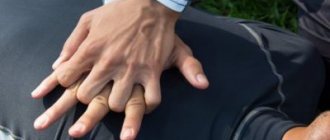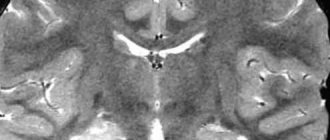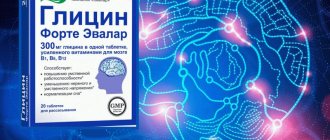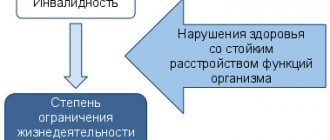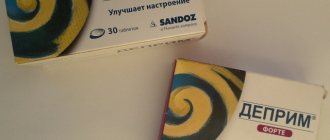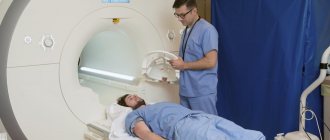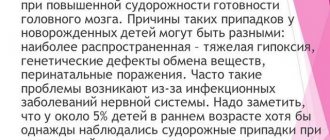If you follow all the recommendations and monitor your condition, then a person can work, have a family and live quite a long time.
Do people die from epilepsy? Death among patients with this disease is quite common.
The majority of deaths from epilepsy are due to suicides and injuries resulting from seizures.
People with epilepsy are ordinary normal members of society.
In practice, they are no different from others; they have the same rights and responsibilities.
The most important thing is the patient’s positive attitude, following medical recommendations, and giving up bad habits.
You definitely need to fill your day with useful and interesting things, communicate with other people, and, if possible, play sports. Treatment and the right lifestyle will help you overcome this disease.
Epilepsy is a serious neurological disease that causes uncontrollable seizures. Treatment of this disease should be carried out comprehensively, including by monitoring the patient’s diet. Diet for epilepsy in adults or children plays an important role in the treatment of this disease. Which products are dangerous to the health of an epileptic, and which, on the contrary, affect the reduction of the intensity of seizures, we will consider in this article.
Proper nutrition for epilepsy has nothing to do with the meaning that proponents of a healthy lifestyle put into it. For a person suffering from epilepsy, not all healthy foods are suitable for a daily diet.
Why is diet necessary at all and why is it so important? Any food contains harmful and beneficial microelements and components, which, in turn, affect the body in one way or another.
If the patient does not control the food he eats, there is a possibility of increased symptoms due to the accumulation of elements that provoke a surge in neural activity (and it is not a fact that these elements are contained in “bad” food; many “healthy” foods are harmful to the epileptic Components).
A diet for epilepsy does not have the function of correcting figure and weight, but of adjusting foods, those that can and those that cannot be eaten.
It is also important to understand that starving yourself, just like malnutrition, is not the case. Hunger strike and oversaturation can become a stimulus for the development of new attacks. The frequency of meals is 4–5 times a day in small portions.
Basic diet
For patients, the most acceptable option would be a ketogenic diet for epilepsy (ketone or ketosis). Its essence is to create a state of ketosis in the body.
Ketosis is the process by which the body breaks down stored fats to produce energy. In ketosis, carbohydrates and other energy sources are not used, only fats.
To achieve ketosis, the patient’s diet is saturated with fatty foods, but this does not mean mindlessly consuming everything that is somehow related to fatty foods. The nutritional plan must be drawn up by the treating specialist.
The epileptic menu must include:
- salo;
- meat with high fat content (pork, lamb);
- dairy products are fatty;
- vegetable oils.
It should be understood that for people with liver problems, such a diet will be disastrous, since a huge amount of fatty food entering the stomach in a short period of time creates additional stress on the liver.
Medicines
To treat an epileptic illness, the doctor prescribes many different drugs that support the patient. However, you should be careful; some medications are strictly prohibited.
For epilepsy, special anticonvulsants are prescribed. In addition to them, actovegin and glycine.
In addition to medications, many patients use special sedative herbs and drugs based on them. Valerian, chamomile, passionflower are the herbs that are recommended to be taken. They increase the effectiveness of anticonvulsants. Medical marijuana therapy is permitted abroad. This is unacceptable in our country.
Some medications may make seizures worse. They contain caffeine and ephedrine. Thus, epileptics should not take: preparations of gingko biloba, St. John's wort ginseng, evening primrose, borage.
It is important for epileptics to take a sufficient amount of the necessary vitamins B, D, E, C. The body of patients does not have enough manganese and magnesium, so additional intake of these drugs is required.
If a person with an epileptic disorder requires surgery under anesthesia, there are no contraindications. But it is not recommended to stop taking your usual medications before or after surgery. In each individual case, the anesthesiologist advises the correct behavior regarding taking pills.
Epilepsy is a common disease today. People suffering from this disease know that the life of such a person depends on himself. Organizing a work and rest schedule, proper nutrition, treatment, physical activity: all this contributes to a fulfilling life filled with bright colors.
Meals for adults
Although the ketogenic diet was originally developed for children, it has begun to be used in adults.
Its meaning is in the monotony of the food received, which includes the products mentioned above. Moreover, to provoke the body to break down accumulated fats, the patient reduces fluid intake (do not forget that everything is individual and only a doctor can prescribe and adjust the amount of fluid consumed).
As a rule, initially, for a day or more, the patient is subjected to therapeutic fasting, which includes restricting food and increasing fluid intake (the drink should not be sweet carbonated water, only water or sweet tea). This fasting is necessary for the accumulation of ketones in the body. To determine their level at the end of fasting, the patient undergoes tests.
If the amount of ketones is sufficient, you can move on to the second stage of the diet - consuming fatty foods.
You should not assume that this stage involves uncontrolled absorption of meat and fats. No, the portions are small and consumed in equal portions throughout the day, so as not to provoke an attack from hunger or overeating.
The effectiveness of such a diet has been proven and lasts from four to six months. This means a reduction in the frequency of attacks. After the intensity of the seizures resumes, the procedure is repeated again.
Job
It is important for people with epilepsy to feel valued in society. Some people assume that only sedentary work is suitable for people with epilepsy. This is wrong. It is important to choose an activity so as not to harm yourself or others. For example, sick people cannot work as a surgeon, driver, or pilot. It is also not recommended to drive, work at heights or in water. In other words, it is prohibited to work where there is a risk of injury.
It should be noted that each individual case is individual and when applying for a job, an epileptic undergoes a medical expert commission, where all controversial issues are resolved. Another point that people with epilepsy need to pay attention to is that they should not overexert themselves. Such workers get tired much faster
People suffering from epilepsy treat work conscientiously, do their work well and honestly. They are characterized by scrupulousness in business, attentiveness, and accuracy. These people always deliver their work on time.
What professions are suitable for an epileptic:
- fashion designer;
- laboratory assistant;
- artist;
- programmer;
- photographer;
- accountant;
- librarian;
- bibliographer;
- tailor.
It is even useful for epileptics to work. According to statistics, such people are less likely to experience attacks if they are employed. A healthy lifestyle and work that brings pleasure helps fight the disease. Work activity also smoothes out other character traits characteristic of epileptics. This is selfishness, excessive irritability, excitability. By doing useful work, a person suffering from this disease becomes happier.
Food for children
As for childhood, the main difference in the procedure that the child undergoes is the timing of the diet. For children, the time is reduced, because the child’s body tolerates such changes more acutely and unpleasant consequences appear earlier.
It is forbidden to feed children fatty foods for more than a week, as the body may react inadequately. On average, such a diet for a baby takes no more than two days (for each individual case, the period may vary).
In addition, it is worth noting that the menu for children may differ slightly from that for adults, as it is based on:
- vegetable juices;
- fruits;
- goat milk;
- fatty cocktails based on dairy products.
The ketogenic diet is not prescribed to children under one year of age, and at the age of 13 years and older, children can eat the same foods as adults.
Reasons for the development of the disease
As we have already written, epilepsy is a chronic disease, so the body may be predisposed to the occurrence of seizures. The disease most often occurs in children from 5 to 18 years old; adults are less susceptible to this type of disease. It is worth highlighting that the appearance of epilepsy can be the cause of a genetic predisposition.
The risk of epilepsy depends on which part of the brain the pathological discharges are formed in. The following reasons can provoke this:
- Various brain defects, such as hematoma, tumor.
- Oxygen starvation of a child still in the womb;
- Jaundice in a newborn;
- Poisoning with various harmful substances (lead, carbon monoxide).
- Birth injuries;
- Hereditary predisposition;
- Traumatic brain injury;
- Down's disease;
All these reasons can result from the occurrence of epilepsy.
If the onset of the disease occurs suddenly, then the exact cause is quite difficult to identify.
Advantages and disadvantages
It is worth understanding that such a diet will certainly have side effects, including:
- nausea;
- hypovitaminosis;
- constipation;
- increase in acidity;
- loss of strength;
- dizziness;
- problems with the gastrointestinal tract.
In addition, this dietary treatment option can trigger the formation of kidney stones, so it is worth weighing the potential benefits against the possible harm.
As for the advantages, they certainly exist, and in addition to reducing the regularity and intensity of epileptic seizures, they include:
- The ability to reduce excess weight (just a few days on such a diet will remove from three to seven kg of excess weight, the main thing is not to gain it later).
- Reducing the risk of developing a heart attack or other heart disease (the pancreas produces less insulin, which has a beneficial effect on cardiac function).
Pros of the ketogenic diet
If you create a menu correctly, fasting should not bring significant discomfort. In this case, much less calories will enter the body. Since the foods are quite fatty, and snacking is also allowed, the patient will not be bothered by a strong feeling of hunger. After starting a diet, the pancreas produces less insulin than usual. This reduces the risk of cardiovascular pathologies.
It is curious that the mentioned diet is used even in oncology. Many specialists note an improvement in the condition of their patients. In 70% of patients with epilepsy, seizures become less frequent. 30% did not feel any difference. After prescribing a ketogenic diet to children, some experienced complete healing. However, it is important to understand that the nature of epilepsy and its severity may vary.
About 35 million people suffer from epilepsy. Chronic brain disease occurs due to head injury, multiple sclerosis, stroke or meningitis. In patients, the pathology manifests itself at an early or old age, but medications do not always help, so diet is a faithful assistant in the treatment of this disease.
Cycles
There are only three cycles of this diet:
- first;
- second;
- third.
In the first cycle, the body prepares for abundant fat “landing”. To do this, the patient is limited in food (or rather, food is excluded) and receives plenty of fluids. As mentioned earlier, this provokes the production of ketones, which will use fats for energy.
The second cycle involves eating fat. Meals are divided evenly throughout the day and, depending on a person’s physique and individual body characteristics, they can be either large or not very large. The main thing is to maintain a balance between overeating and staying hungry.
The third cycle is a gradual exit from the ketogenic diet. A sharp restriction of fatty foods is fraught with consequences, as is procrastination. Therefore, the patient gradually reduces the amount of fatty foods, replacing them with a normal, daily diet.
Treatment of epilepsy at the Yusupov Hospital
There are several different directions in the issue of nutrition in epilepsy, depending on the concomitant pathology and for the prevention of possible complications associated with taking antiepileptic drugs. Let's consider the options and we can choose our own diet.
Diet is a system of accepted rules for eating food.
diet for epilepsy
chemical composition (proteins, fats, carbohydrates, mineral salts),
physical properties (temperature, consistency),
culinary processing (boiling, frying).
The basic principle of proper nutrition: rationality.
According to modern scientific concepts at the intersection of epileptology and dietetics, nutrition for epilepsy meets the basic requirements for healthy people without epilepsy.
The diet must be balanced in proteins, fats, carbohydrates and mineral salts, and contain essential elements to ensure normal functioning. Comply in quantity and energy needs with age, gender, and professional standards for a healthy balanced diet. The diet should be varied and include meat, fish, vegetables, fruits, cereals, and dairy products.
The emotional side of the diet for epilepsy.
Food should bring satisfaction, and not be an option for “therapeutic nutrition”. Preserve established food traditions, taking into account nationality, individual culinary preferences, and capabilities.
Food is a natural need of the body, as well as one of the important components of life. Refusal of certain foods in the diet also reduces the quality of life. If there are no grounds for unnecessary restrictions, then it makes no sense to infringe on a person. It is necessary to instill the desire to eat healthy from an early age.
At the Yusupov Hospital you can undergo a full course of epilepsy treatment. Doctors at the Yusupov Hospital use the latest methods of treating the disease, which have proven their effectiveness in domestic and foreign clinical studies. The patient may be treated with a ketogenic diet if indicated.
You can make an appointment with neurologists, epileptologists, nutritionists, undergo an examination, and get more information by calling the Yusupov Hospital.
Olga Vladimirovna Boyko
What you can and cannot eat
The ketogenic diet is not medically suitable for everyone. If it is impossible to use this option, do not forget about prohibited foods. Thus, the following are prohibited for epileptics:
- salty dishes (meaning foods with a high salt content);
- smoked meat and fish products;
- legumes;
- coffee (you shouldn’t completely exclude coffee products, but you should limit them);
- spices and herbs (vinegar, mustard, horseradish are prohibited).
Particular attention should be paid to alcohol. Epilepsy and alcohol create consequences that lead to serious health problems. In addition to the fact that alcoholic drinks can provoke an attack of illness, there is such a thing as alcoholic epilepsy, which develops in alcoholics during alcoholism, as well as in former alcoholics and even in people who have consumed a large dose of alcohol once.
Moreover, drinking has a negative effect on taking medications. Despite the fact that there is practically no interaction between tablets and alcohol, a problem can occur when a person misses a dose of medication when he or she is intoxicated. As is known, in the treatment of epilepsy, regular intake of medications is important, and even a single omission can cause a deterioration in the patient’s condition.
Thus, the clear answer to the question of whether you can drink alcohol with epilepsy is no.
TV
Should I give up my TV and computer?
In a small percentage of people with epilepsy and light sensitivity, watching television can trigger a seizure. But you can watch it if you take the following precautions:
- the distance between a person and the TV must be at least two meters;
- In addition to the TV in the room, there must be another source of lighting;
- You shouldn’t opt for big screens;
- The eyes of the viewer should be at the level of the screen.
As for the computer, an epileptic can work on it. But we must not forget about the safety rules:
- the room in which the computer is located should be bright;
- there should be no glare on the monitor from the light source falling on the monitor;
- the distance between the eyes and the computer is 30–35 centimeters;
- you need to work only in a calm state, a person should not be tired or exhausted; frequent eye breaks should be taken. The same rules apply to video games.
Gluten-free diet for epilepsy
In addition to the ketogenic diet, a gluten-free diet is considered acceptable for epilepsy. This type of diet implies a person’s complete refusal of flour products or their replacement with products prepared without the use of gluten.
It is believed that if you eat using one of the two diets, you can achieve a lasting effect for several months. The difference between the second type of diet is that you can stick to it a little longer than the first.
But it is also necessary to prepare for a gluten-free diet and switch to it gradually so as not to cause a sudden blow to the body.
Family and Children
What can you do for epilepsy? Despite many contraindications, people with epileptic disease are full members of society. They can engage in certain activities, have family and friends.
Can people with epilepsy have children? If an epileptic woman has a close relationship with her partner in her life, then she may well become pregnant and give birth to a baby. But you should prepare for the pregnancy process in advance.
Seizures of the disease can pose a threat to bearing a baby. During attacks, there is a high probability of injury; as a result, placental abruption may develop. A pregnant woman needs to more carefully monitor her daily routine, rest, and nutrition. It is important to take the right vitamins, folic acid and others. However, throughout the entire period of bearing the baby, the woman takes anticonvulsants. The better a woman’s health and well-being, the higher the chances of giving birth to a healthy child and raising him.
A woman suffering from epilepsy can give birth either by caesarean section or naturally. However, it is important to remember that the baby receives AEDs (anti-epileptic drugs) from the mother during pregnancy and after birth. You should be prepared for the possibility that your newborn will experience allergic reactions.
Arrange your home
Kitchen:
Those suffering from epilepsy should pay attention to this particular room.
- Replace glassware and ceramics. Use plastic utensils or utensils made from other unbreakable materials;
— to use knives less, buy foods (bread, cheese, sausage, some vegetables) in sliced form. Use a knife only in the presence of other family members. If you are lonely, try to spend more time with friends and neighbors;
- If possible, avoid using a gas stove. It is better to use a multicooker or microwave oven with a timer to turn off the device. If this option is not possible, then someone should be with you when you turn on the gas. Keep boiling water in a thermos so you don't have to reheat the water often.
Bathroom and toilet:
— it is best to replace the bathtub with a shower stall. A hot bath can trigger an attack. You should also not take a shower or wash your face with too hot or cold water;
- if the floor and walls are made of tiles, a rug and soft screens are required. It is not recommended to keep electrical appliances (hair dryer, electric razor) and manicure accessories in the bathroom;
- do not close the door when you are in these rooms. It is better to use identification marks on the door for this. The family will know that the room is occupied. Try talking or humming - this will help you understand that you are okay.
Living room and bedroom:
- rearrange the rooms so that furniture with sharp corners is least accessible or cover the corners with soft fabric;
— the floor must be covered with soft carpets or carpet;
— remove heaters from the aisles and secure them well to avoid the devices falling;
— try to keep irons and other electrical appliances in closed cabinets.
Home improvement
The comfort and safety of a person with epilepsy depends on the arrangement of objects in the house. It is better to replace kitchenware made of ceramics and glass with plastic ones. It is also important not to use knives frequently. A gas stove is not the best option for a person suffering from epilepsy.
You should be careful when choosing furniture. Also, you should not furnish the room with tables and sofas with sharp corners. It would be good if there was a soft carpet on the floor.
Sharp accessories can also be dangerous. It is better to avoid glass attributes. You should not put them in a visible place. The safety of the bathroom implies the absence of electrical appliances and razors in the public domain. It is not recommended to close. It's better to put up a "busy" sign. Otherwise, the patient will not be able to receive help.
For a person suffering from epilepsy, various stepladders and ladders are dangerous. Therefore, living in a multi-story building without an elevator is dangerous for epileptics.
Eat wisely
Nutrition is an important part of the life of a person with epilepsy. The effectiveness of treatment depends on how a person eats. Epilepsy is not a reason to completely eliminate your favorite foods from your diet. It is important to follow the recommendations, but try to organically fit them into your usual diet. In this case, it is necessary to take into account other diseases that the patient with epilepsy has. Therefore, they create a diet taking into account the recommendations of specialists.
Basic nutritional requirements for a patient with epilepsy:
- completely eliminate bad habits - smoking, alcohol, taking drugs;
- Maintain proper water regime. Do not drink large amounts of liquids (this can cause an attack), but thoughtless restriction will lead to the same result. You should not use liquid removal products, just try to balance your water intake.
- Minimize the amount of spicy, salty foods and smoked foods. To this list should be added foods high in nitrogen - beans, beans, peas.
- do not give up meat and fish (preferably boiled), vegetables, cereals and dairy products. Try to make your menu varied and balanced. This will help good bowel function, which is important for patients with epilepsy;
- Avoid overeating, have dinner no later than two hours before bedtime. Try not to drink a lot before bed;
- Consult your doctor about fasting days. Fasting is beneficial for epilepsy, but it is best done under supervision.
Prohibited Products
At the first suspicion of epilepsy, the doctor is obliged to inform what adults and children should not eat or drink if they are ill, and what they can. Later, the list of prohibited products will be clarified depending on the characteristics of the patient’s body, his reactions to the withdrawal or introduction of a particular product.
To reduce the frequency of attacks and avoid their intensification, it is necessary to limit the consumption of starch, sugar, and some related substances as much as possible. It is on this basis that a list of excluded foods is formed.
Products prohibited for epilepsy:
- sugar;
- any sweets, especially those made from different types of flour.
- flour products of any kind (pasta, bread, dumplings);
- low-fat foods of any type;
- alcohol;
- carbonated drinks;
- drinks containing caffeine;
- sweet fruits, berries (pears, peaches, apricots, raspberries, strawberries, cherries are strictly prohibited);
- starchy vegetables (potatoes, pumpkin, sweet potatoes);
- legumes of any type.
The most common question for doctors is: “is it possible to drink coffee with epilepsy in adults and children and what sweets are allowed, what drinks?” The specialist’s answer will be clear.
Under no circumstances should you drink coffee, strong tea of any kind, or sweets if you have epilepsy. And any sweetness, even the most natural one, brings a person closer to another attack.
What can you eat?
The basis of dietary nutrition for epilepsy is foods high in fat and protein, carbohydrates and sugars, while trying to avoid. What you can eat and what you can’t eat, what foods to eat if you have epilepsy - the doctor will tell you, he will develop a suitable diet for the patient after receiving the results of all the studies.
Products that are useful for epilepsy:
- non-dietary meat: beef, veal, pork will be an excellent basis for the diet, preferred cooking method: boiling, steaming;
- poultry without restrictions;
- by-products, especially liver, heart or brains; both poultry and animal by-products are suitable;
- seafood - squid, mussels, shrimp, seaweed are not only rich in essential protein and fats, but also contain many useful substances that have a beneficial effect on other body systems;
- fatty fish, prepared in any way; it is most useful when baked, boiled or steamed;
- milk and any dairy products, some cheeses are especially useful for epilepsy;
- dairy products;
- eggs;
- nuts (cashews, almonds, walnuts, hazelnuts, pine).
- various vegetable oils, the most useful of which are coconut, flaxseed, olive and sunflower.
The basic rule for creating a menu for epilepsy: as little starch and sugar as possible. Based on this, in order not to provoke seizures in epilepsy, fruits can only be low in sugar: apples, grapefruits, pineapples, oranges.
The list of permitted vegetables is also strictly limited. For an epileptic person, you can add some greens, cucumbers, tomatoes, and cabbage to your diet.
Extremely strict restrictions regarding the products that make up our usual diet have a detrimental effect on the functioning of the body. As a rule, this affects the functioning of the gastrointestinal tract and the balance of vitamins and nutrients.
Therefore, when prescribing a diet, the attending physician also prescribes vitamin and mineral complexes for adults and children, which will reduce the impact of one-sided nutrition on the functioning of internal organs.
Contraindications
When prescribing a nutritional plan for epilepsy for a child or adult, the doctor must take into account the characteristics of the body, chronic diseases and pathologies of the patient.
Since an increased amount of fat with a low protein and carbohydrate content can provoke the development of diseases of internal organs.
Therefore, a number of contraindications have been developed in which it is prohibited to adhere to the ketogenic diet:
- obesity;
- diabetes;
- kidney and liver diseases;
- food allergies;
- metabolic disorder;
- pancreatitis, exacerbation of a chronic process;
- atherosclerosis - deposition of cholesterol in
- vessels;
- malabsorption syndrome, in which the inner walls of the stomach and intestines do not absorb the required amount of vitamins and nutrients);
- encephalopathy and serious damage to the cerebral cortex.
- diseases that provoke disturbances in blood circulation in the brain area;
- heart disease;
- acute ARVI.
You should stick to the epileptic menu only if the attending physician believes that this measure will help cope with seizures.
If your condition changes, other diseases develop, or side effects occur, you must inform your doctor about this in order to adjust your diet in time.
Consequences
Despite the benefits of using a diet of approved foods in the treatment of epilepsy, children, adolescents and adults may experience constipation and regular disturbances in the functioning of the gastrointestinal tract due to nutrition. This is the result of dietary fat consumption, vitamin deficiency, and monotonous diet. In addition, in some cases, other side effects develop:
- drowsiness, fatigue at first, while the body switches to a new source of energy;
- nausea, periodic dizziness;
- weight change, corrected with physical exercise;
- increased cholesterol levels;
- hair loss;
- bloating, gastrointestinal disturbances.
Such phenomena are temporary and can be eliminated by adjusting the diet or eliminating special foods. However, only the attending physicians decide to change the diet, who will help you choose the right combinations according to the table of the most useful and necessary products for epilepsy, and add vitamin complexes.
Losing weight with epilepsy
In the treatment of epilepsy, a ketogenic diet is used, which provides nutritious nutrition for children. But adults end up with an excessively high-calorie menu. Therefore, there is a need to additionally monitor your weight.
Ketogenic nutrition assumes a fat to protein ratio of 3:1, which in an adult will soon lead to weight gain.
To maintain proper nutrition, which reduces the likelihood of epileptic attacks, and at the same time not to gain weight, you can switch to a special Atkins diet menu. It is a lightweight, balanced, taking into account the characteristics of the age-related body, ketone diet, necessary for epilepsy. And, of course, maintain the required level of physical activity.
Optimize behavior
In everyday life:
- When watching TV, follow the recommendations for patients with epilepsy. Try not to sit closer than two meters to the screen; place it at eye level. It is necessary to turn on additional lighting in the room other than the TV screen while watching. A regular TV is preferable, a home theater is not desirable;
— When working on a computer, the rules are not much different. You should take frequent breaks and avoid getting tired. The lighting in the room should be optimal. Bright light is as undesirable as twilight;
— do not fly on planes with frequent time zone changes.
At work:
- do not hide the disease from your work colleagues. Try to tell others how others should behave during an attack;
- refuse to work at night and shift work;
- Bring a change of clothes to your workplace in case of an attack.
When playing sports:
- exclude participation in traumatic sports and professional sports;
- swimming is not prohibited. Postpone visiting the pool if you feel generally unwell or if attacks become more frequent. Do not swim in cold water; diving and diving are prohibited. Wear a bright cap and try to swim in pairs, avoid large crowds of people.
- cycling, horse riding only under supervision and the presence of restrictive devices that allow you to keep the body from falling, as well as a helmet on the head;
- avoid busy streets;
- very limitedly engage in sports with dangerous devices (sword, weapons) and associated with climbing to heights.
Trips
People with epileptic illness benefit from traveling. Some even write blogs about how to do this if you are diagnosed with epilepsy. But you need to be more careful when organizing trips than ordinary people.
Epileptics can travel by car, train, or bus. It's good if you don't travel alone.
Since epilepsy is an insidious and complex disease, it is not recommended to fly with it. However, there are no contraindications to this. If this type of travel is the most optimal, the passenger must take with him on the plane the necessary
medicines. Before traveling by any type of transport, the patient should consult with the attending physician, and also have a good rest and gain strength.
If your child has epilepsy
The main task of parents is to help a child suffering from epilepsy not feel sick. It is necessary to talk, explain to the baby everything that is happening, and teach him to notice the symptoms of an attack. Try to give him maximum independence (as far as the degree of epilepsy allows) and carry out simple tasks “within his strength.”
If visiting a child care facility is not prohibited, then tell the staff in detail about your child’s problems. Moderate exercise is necessary, but under the supervision of adults and a doctor.
Epilepsy is not a sentence, but a certain way of life.
Epilepsy is a serious illness that is characterized by impaired consciousness, mood swings and other manifestations.
Recently, the ketogenic diet method has been used in the treatment of epilepsy, which leads to quite positive results.
This method of therapy is a diet with a maximum fat content and a minimum carbohydrate content. With the help of such nutrition it is possible to control. The diet is prescribed by the attending physician and is strictly monitored by a nutritionist.
The name comes from the concept of “ketones,” which means formations that are formed during the metabolism of fats as an energy source. As you know, in order to produce energy, the body uses carbohydrates, which are found in various foods.
But since the diet involves limiting them, fats become the source of energy. Ketones pose no threat to the body and can be found in urine and blood.
Forms of seizures and their symptoms
There are many types of seizures in epilepsy, but they are divided into only 2 groups.
- Partial (focal) seizures;
- Generalized;
Partial seizures occur as a result of pathological impulses in a separate area of the brain. Partial seizures occur in approximately 55% of affected people.
In partial attacks, the following symptoms are distinguished:
- Emotional instability (sudden attacks of joy, aggression, fear, anger);
- Nausea and vomiting;
- Impaired consciousness accompanied by loss of consciousness (fainting).
- Spasmodic movements of the eyes and mouth.
- Non-purposeful motor movements, such as walking in a circle.
- The appearance of an aura.
Symptoms of partial seizures may resemble other diseases. Different symptoms of the disease can be mistaken for any mental disorder, narcolepsy. Additional research is required to accurately identify the diagnosis.
Generalized seizures indicate abnormal neural activity in both parts of the brain.
Generalized attacks have the following symptoms:
- Fainting or loss of consciousness;
- Pronounced muscle spasms;
There are quite a few types of attacks in this form. During a tonic attack, the muscles of the back, arms and legs become numb. Clonic seizures can cause muscle spasms (twitching) throughout the body. Other types of generalized seizures have similar symptoms.
What is the essence of the diet?
The mechanism of long-term restriction in essential nutrients that enter the body with various foods acts in such a way that the frequency of epileptic seizures is significantly reduced. Sometimes attacks disappear completely, which allows a person to live a full life.
After prescribing a diet, the doctor constantly monitors the patient’s condition and, if any complications arise or the condition worsens, takes the necessary measures.
The main principle of the diet is based on fasting. During the first three days, the patient should drink boiled or filtered water. It is strictly forbidden to use mineral water due to its composition.
During the fasting regime, physical activity should be minimized, in some cases even bed rest is required.
After three days of fasting, the patient switches to eating solid food. This transition must be carried out gradually.
The daily food intake is divided into small portions (about 3 times less than usual). Eating occurs more than five times a day.
It is very important that the patient himself learns to calculate the amount of necessary nutrients that are necessary to maintain normal functioning and general physical condition.
Safety – what an epileptic cannot do
- a person suffering from epilepsy should not drive a vehicle;
- Avoid carrying or lifting hot objects and liquids;
- To avoid thermal damage, prefer a microwave oven to a conventional stove;
- Arrange furniture and objects in such a way that the risk of damage in the event of a fall is as small as possible.
- Radiators and stoves can be insulated,
- do not lock the doors in the bathroom and toilet; it is recommended to install doors that open outward;
- When at home alone, avoid taking a shower or bath;
- When leaving home, take enough medications with you;
- do not swim without supervision; when riding a boat, be sure to wear a life jacket.
Help during an epileptic seizure
Epileptic seizures usually stop on their own after about 1 to 5 minutes.
When providing assistance:
- keep calm;
- When warning signs appear, place the patient in bed, on the floor or on the ground. Loosen clothing, especially shirt collars.
- if possible, take the patient away from nearby dangerous areas (roadways, bodies of water, the possibility of falling, sharp objects, etc.);
- monitor the patient until he regains consciousness, find out the duration of the seizure;
- after convulsions, the patient has no cough and swallowing reflex. To prevent saliva or vomit from entering the respiratory tract, turn the patient on his side and leave him lying in this position.
- After the attack, the patient is in a slightly foggy and sleepy state. Let him lie down and sleep.
- Sometimes, after a seizure, agitation may occur. Calmly wait for it to pass.
What not to do during an attack
- Do not put anything in the patient’s mouth! A common misconception is that you need to place something between your teeth. Tongue biting occurs immediately after the attack begins, and it is impossible to avoid it; moreover, it does not pose any particular danger. By placing a hard object in the mouth, there is a danger of breaking teeth, causing the patient to vomit, damaging the oral cavity, etc.;
- do not try to “counteract” hardened muscles;
- during an attack, do not offer the patient anything to drink, and do not pour water on the patient;
- do not try to resuscitate the patient;
- It is useless to try to revive a patient who is in a relaxed, unconscious state by shaking and clapping and letting him smell ammonia.
Israeli neurologists often help cure epilepsy even in the most difficult cases. We are constantly adding new methods and drugs, leave your information and our consulting doctor will talk to you by phone and answer all your questions.
Features of the diet for children
As for the treatment of children with epilepsy from one to twelve years of age, a ketogenic diet is prescribed in cases where seizures cannot be controlled with antiepileptic drugs. Most often, the diet is prescribed to patients with the syndrome.
Also, many data indicate that very high results can be achieved in the treatment of the following pathologies:
- Dravet syndrome;
- Bourneville disease;
- Duse syndrome;
- motor spasms.
In general, this diet can be used in combination with other therapy for each case of the disease, unless there are specific contraindications.
A slightly modified diet is used to treat children. The main difference from the standard diet is the principle of using special fatty cocktails, which are made on a milk basis. This drink has a special composition developed by a specialist nutritionist.
An analogue of a cocktail can be ice cream prepared according to the same principle. Thanks to this diet, children get used to eating very fatty foods, which have an antiepileptic effect. The rest of the dishes that are included in the menu are selected by the doctor.
What a person with epilepsy should not do
People with epilepsy can lead a normal life: have children, play sports, work. However, circumstances that could trigger an attack should be avoided:
- lack of sleep,
- alcohol consumption,
- cold viral diseases with fever,
- taking certain medications that stimulate the central nervous system, hypoglycemic conditions, or other metabolic factors such as flashes of light.
Video games are a special case, as only some people are sensitive to them. As for sports, it is important to avoid those activities where loss of consciousness or involuntary movements can lead to serious consequences (falling, loss of control, etc., for example, mountain climbing and diving).
Some patients may be affected by very specific factors: unexpected noises, reading, strong emotions, prolonged concentration.
A neurologist must carefully study each individual case. Working at a computer, contrary to popular belief, is not contraindicated for patients with epilepsy, unless they have proven sensitivity to screens, which is extremely rare in the presence of flat screens. Therefore, epilepsy should not be a contraindication for computer work.
In all cases, it is important to continue taking all prescribed antiepileptic drugs .
Contraindications and side effects
People with epilepsy are prohibited from starting a diet on their own. Before starting, you should definitely consult your doctor, as there are some contraindications for it:
- kidney and liver diseases - a huge amount of fat has a detrimental effect on these organs, i.e. they may simply not cope with the load;
- heart and vascular diseases;
- metabolic disorder;
- diabetes - if this rule is not followed, the diet can cause the most severe consequences;
- diseases of the endocrine system.
When following a diet, it is very important to keep a special diary in which you need to note the frequency and duration of convulsive seizures.
The resulting statistics will help the doctor determine the duration of the diet.
In some cases, there is a risk of various side effects:
- decreased physical activity;
- regular constipation;
- formation of kidney stones;
- decrease in blood acidity levels;
- dehydration;
- weakening of bones, and as a result - the risk of frequent fractures;
- increased cholesterol levels.
Those people for whom this diet is contraindicated should limit themselves to consuming poorly digestible, heavy, spicy, salty, smoked foods and marinades. It is also necessary to reduce fluid intake in any form.
Sport
Exercise is not contraindicated for people with epilepsy. However, the choice of a particular sport should occur with the participation of a doctor. Weightlifting or athletics is not the best option for an epileptic. But team games such as volleyball and football are useful. The doctor may also recommend gymnastics. However, it is important that you do not overexert yourself during any activity.
You don't have to give up the pool at all. But it is important to take precautions:
- there should be a person next to the epileptic who is swimming who can help him in case of danger;
- It is not recommended to dive (from a tower or pool);
- the pool water temperature should not be too low;
- You should not visit the pool when you are feeling unwell;
- The depth of the pool should not be large, and you should not swim too far.
Sample menu for 6 days
The menu is compiled for 6 days and may look like this. The first three days, plain water.
- 2 boiled chicken eggs, a small spoon of butter, coffee with cream;
- 2 sausages, a teaspoon of mayonnaise, half a tomato;
- fat cottage cheese with sour cream (150 gr.);
- boiled chicken breast with butter (10 g);
- steam beans with olive oil (2 tablespoons).
- 4 hard-boiled quail eggs;
- coffee with cream;
- 150 gr. boiled beef;
- boiled turkey meat;
- tomatoes with mayonnaise;
- a small piece of boiled lean fish;
- boiled asparagus.
Small snacks are allowed between main meals. You can eat:
- yogurt;
- fermented baked milk;
- kefir;
- cottage cheese.
Dish recipes
There are many interesting recipes for nutritious and tasty dishes. Here are some of them:
Scrambled eggs and ham
Products:
- 2 eggs;
- 50 gr. ham;
- 50 gr. processed cheese;
- 1 tbsp. spoon of butter;
- herbs and/or seasonings.
Fry the ham, then beat in the eggs. Towards the end of the cooking process, add cheese and cook the dish over low heat for several minutes. Season with herbs or spices before use.
Grilled sweet peppers
- Products:
- 2 pcs. Luke;
- spices (to taste);
- 200 gr. pepper;
- 1 tbsp. spoon of olives;
- 2 tbsp. spoons of olive oil;
- 1 teaspoon capers;
- vinegar.
Chop the peppers and marinate them in a pre-prepared sauce from the above ingredients. Place on a baking sheet and bake until done.
Products:
- 450 gr. turnip;
- 150-200 gr. cheese;
- 1 chicken egg;
- 1 tbsp. spoon of butter;
- 2 tbsp. spoons of sour cream;
- greenery;
- seasonings, salt.
Pour the peeled turnips with water and cook for about an hour. Then cool, beat in a blender and mix with spices and sour cream. Then beat in the egg and add the cheese, then beat the ingredients in a blender again.
Place this mass in a mold and place in the oven (temperature should not be less than 170 degrees). The dish should be cooked until a crust appears. At the end, sprinkle herbs and spices on top.
What is the Atkins diet?
This diet is less strict than the ketone diet, but it is recommended that you try it first. Nutrition with limited carbohydrates, on its basis the Hollywood, Kremlin diet, and various diets for weight loss developed. It was originally developed as a weight loss diet.
The modified Atkins diet for epilepsy involves a 50/50 split of nutrition, that is, fats should be 50%, and carbohydrates and proteins should be 25%. This cardiologist suggested reducing carbohydrate consumption, as a result of which the body begins to work in a new way and metabolic processes accelerate.
The diet is divided into several stages:
- The first phase is called the ketone phase. During this period, you are allowed to eat no more than 20 g of carbohydrates per day. The body, not receiving energy in the usual way, begins to waste fat reserves, at which time acidosis occurs;
- But you should only eat when you are really hungry. You can’t overeat, fill your stomach, you need to adhere to moderation;
- At the second stage, some carbohydrates, cereals, and fruits are introduced;
- The third stage is maintenance - the diet is followed for the rest of your life.
Can:
Chicken, lamb, pork, ham. Any type of fish: mackerel, salmon, sardine, herring, all types of river fish. Seafood should choose those that contain fewer carbohydrates, and carefully study the composition on the labels.
Among vegetables, preference is given to radishes, radishes, cucumbers, bell peppers, and celery. You can also add sprouted seeds and wheat shoots, mushrooms, fish oil, butter, herbs, and herbs.
It is forbidden:
Reduce salt intake to a minimum, and eliminate it altogether in the first two weeks. You will have to give up confectionery, sugar, margarine, and all sweets. At first, exclude potatoes and pasta.
The Atkins diet is more preferable for children with epilepsy; it is not so strict; special restrictions need to be adhered to only in the first days. However, there are many types of epilepsy, so diet therapy may help one person but not another.

